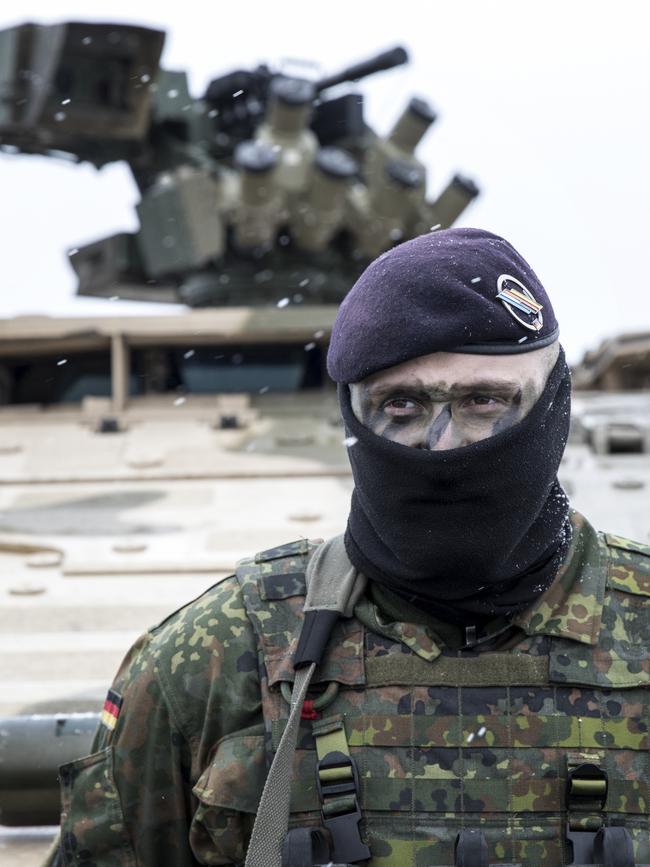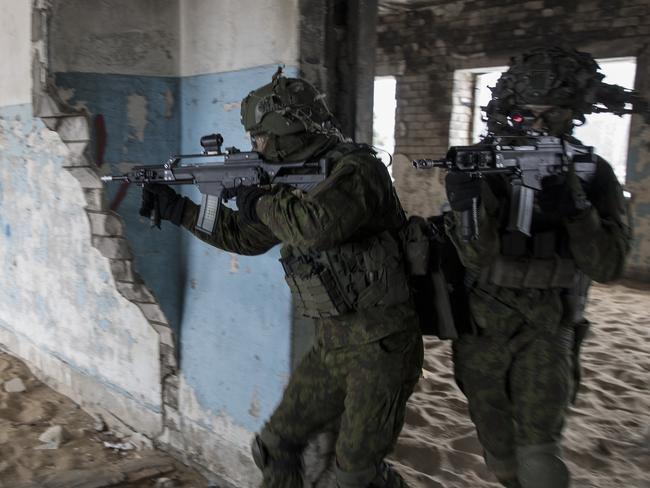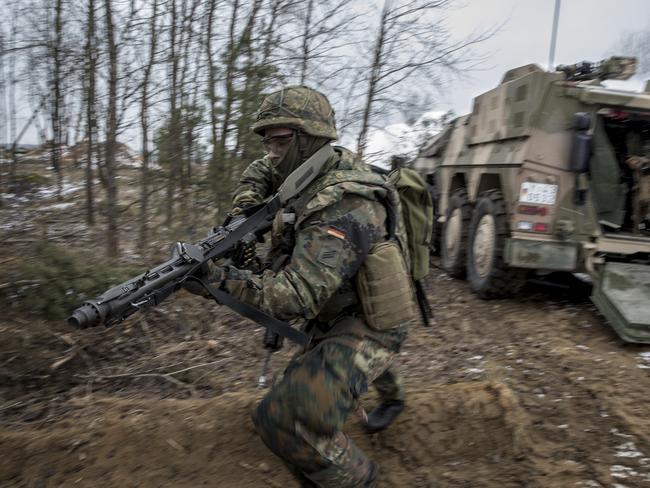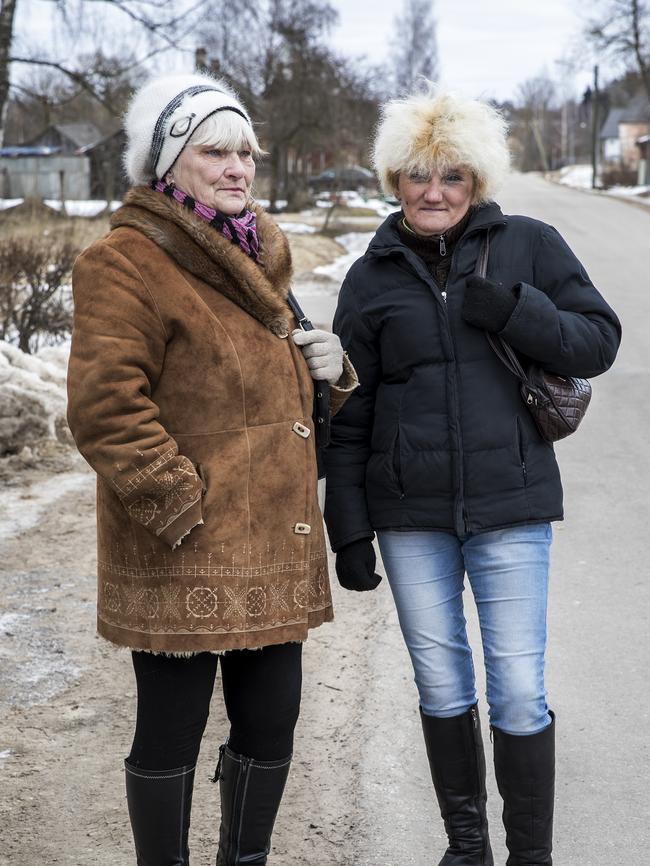NATO troops deployed across eastern Europe in push to stare down the might of Russian army
WITH the relationship between Russia and the west at its lowest since the Cold War, News Corp goes behind the scenes with NATO troops who are bolstering their presence along Russia’s borders.
World
Don't miss out on the headlines from World. Followed categories will be added to My News.
ON a snow-covered airfield in Lithuania, heavily-armed NATO troops emerge from tanks, advancing through smoke and gunfire to a ruined building to attack the enemy inside.
It’s a training exercise with troops from the seven nations deployed here, and it’s sending a message across the border to Russia, where Vladimir Putin has amassed thousands of troops within easy striking distance of eastern Europe.
With the relationship between Russia and the west is at its lowest ebb since the Cold War, NATO, the military alliance between 29 countries across Europe and North America, is bolstering its presence along Russia’s western borders.
Eight neighbouring countries now have a NATO headquarters, while four — Estonia, Latvia, Lithuania and Poland — are hosting a battle-group of war-ready soldiers, led by big NATO countries Germany, Canada, the UK and US.
MORE: Australia’s expulsion of two Russian diplomats will have ‘consequences’

While the 4500 troops in the battle-groups would be no match for the soldiers who can be easily mobilised from across the border in Russia, and in the heavily-militarised enclave of Kaliningrad, they’re part of a wider NATO response.
“When one country is attacked, all countries are attacked,’’ said the commanding officer of the National Integration Forces in Lithuania, Colonel Jakob Larsen, invoking NATO’s “Musketeer’’ Article 5.
“It’s not about the size, it’s about the flags. It is political to demonstrate that we stand together.’’
MORE: Russia fires back at Malcolm Turnbull’s remarks
Col. Larsen, from Denmark, said NATO’s decision-making body, the North Atlantic Council, had made a “proper decision to send a very clear signal to any opponent that has an interest to occupy or be aggressive on NATO territory.’’
“But again the whole purpose is to prevent a crisis to evolve or start. NATO is not interested in a conflict. It is a clear signal to any person or states who want to interfere in a NATO business that they should not do it,’’ he said.


The recent nerve agent attack on former Russian spy Sergei Skripal in the UK town of Salisbury has put renewed focus on Russian aggression and intervention offshore.
Following the UK’s lead, allies including the US and Australia, and from across the EU and NATO countries, this week ordered a mass expulsion of Russian diplomats in a bid to dismantle Russia’s spy western network.
More than 130 suspected spies were ordered out of 25 nations, including 60 people from the US, and two from Australia who were accused of being undeclared spies, in the biggest purge of Russian espionage figures in history.
Russian expert Judy Dempsey, from the Carnegie Endowment for International Peace, said the relationship between Russia and Europe was “awful.’’
MORE: ‘There are no spies in Russian embassy’: Russian ambassador to Australia
“The fact that the sanctions are being rolled over, and the relationship is exacerbated between Russia and the UK over the spy case. It is very bad,’’ she told News Corp.
“And between NATO and Russia is it also very bad.’’
Ms Dempsey said there were “tens of thousands’’ of Russian troops able to quickly mobilise in Belarus and Kaliningrad.
“There’s no match (with the NATO battle-groups), it’s chalk and cheese,’’ she said.
“It’s more psychological for the Baltic States ... you touch one of these countries and we will all be united.
“The numbers are too small but the psychological and political significance is very important.’’

Ms Dempsey said NATO was slowly rebuilding the infrastructure it had dismantled at the end of the Cold War in 1989.
“There was a big hole in this part of NATO, there was always a defence hole,’’ she said of the former Soviet satellite countries that are now NATO members.
“The question is, would Russia put it to the test? It’s very hard to see Russia doing that.’’
Ms Dempsey said she did not believe the renewed aggression of Russia indicated a new Cold War.
“The Cold War was ideological. There was the ideology of the West and there was the communist ideology.
“In this post-Cold War period Russia is trying to assert itself, at a time when the West is unsure of its own power, given what is going on in the United States (the Trump presidency) and with the European Union (Brexit).
“It’s not a new Cold War. Essentially Russia is a disruptive force.’’
While Russia’s invasion of Ukraine and annexation of Crimea — the first hostile taking of land in Europe since World War II — were the original triggers for the economic sanctions and military build-up in eastern Europe, NATO has been further alarmed by Putin’s growing aggression.
Examples cited by NATO include Russian meddling in the US election process, industrial-scale manipulation of social media and dissemination of fake news, intervention in the Syrian civil war to prop up dictator Bashar al-Assad, building the missile which brought down the civilian passenger jet MH17 over Ukraine in 2014 with the loss of 293 lives, including 40 Australian citizens and residents, arming and supporting the pro-Moscow rebels fighting in Ukraine, and, most recently, the use of a Soviet-era nerve agent novichok to attack Sergei Skripal and his daughter Yulia, who both remain in a critical condition in hospital.
In the wake of the assassination attempt on Mr Skripal, News Corp this month visited Latvia and Lithuania, and found not everyone shared NATO’s concerns.

In the border town a Zilupe, the nearest Latvian population to the border with Russia, every person News Corp spoke to questioned whether Russia posed any threat.
Olga Kosmaceva, 35, said: “I’m a Pacifist. I don’t like that NATO is here, it’s not necessary. We haven’t a problem with Russia,’’ she said.
“Friends (with Russia), no, but Russia is not a demon. (It’s) a neighbour.’’
Friends Anjelika and Ludmilla both said they had concerns about NATO’s presence and questioned why they were there.
“Of course we do not need war,’’ Anjelika said, but added that Russia was “not a problem.’’ While Zilupe has strong cultural connections to Russia, none of the people News Corp spoke to identified as Russian.
Ludmilla said she believed Latvia and Russia were “friends.’’
Another woman in Zilupe, Irina, said: “Speaking personally, I don’t think it (the NATO presence) is necessary. We respect Russia more closely.’’
Further south in the city of Daugavpils, university student and waitress May Pantalejes, 20, raised concerns about the impact of the economic sanctions imposed by the US, Europe, Canada, Australia and Japan after Russia annexed Crimea.
“I think it’s a bad thing because, many years ago we had conversations (about trade) with Russia,’’ she said.
“We need conversations because there are many things we do together, for example the trains. In Daugavpils it’s very old and very important that we had communications with Russia.
“But with the American sanctions we lose money. For economics it is very bad, many people in Latvia lose their jobs, for example the coal, and benzene.
“For many people it is bad, they lost their job and now it is very difficult.’’



Across the border in Lithuania, Ministry for Defence Vice-Minister Giedrimas Jeglinskas said the NATO mission was designed to “show strength.’’
“The objective of our deterrence is to ensure the Russian make calculations … and they come to the conclusion that it’s not worth it, not worth causing damage, not worth waging war against these countries because these countries are too strong,’’ he told News Corp.
“NATO is there, boots on the grounds, it’s really the overall deterrent effect that is truly important for our security.’’
Mr Jeglinskas, who worked for 2.5 years in Australia as a Citigroup banker, said the enhanced forward presence by NATO was a “great step’’ but an expanded response was being considered.
“There are some discussions as well within NATO, and we’re all for that, to expand the whole mandate of the EFP, now purely a land domain, into air and maritime, but again that’s probably discussions for the future rather than now,’’ he said.
“It is a deterrent and we’re absolutely happy with this arrangement and we very much appreciate every countries contribution.’’
NATO — the North Atlantic Treaty Organisation formed in 1949 — decided in 2016 to ramp up its defence, and the battle-groups were deployed in February 2017.
NATO also tripled the size of its response force to 40,000 troops, including a “high-readiness’’ force at its core.
“These forces are a defensive and proportionate deterrent force, fully in line with NATO’s international commitments. They send a clear message that an attack on one ally would be met by troops from across the alliance,’’ NATO said.
Col. Larsen said his job was to be an advance team for any incoming reinforcements, and be the eyes and ears on the ground.
“All the headquarters are tasked to be visible and permanent presence and also to have the ability to receive reinforcements tonight,’’ he said.
“NATO has for many, many years now had our area of operations in Afghanistan, Kosovo, Iraq and now we have to go back to the business again of ... the collective deterrence, about having to protect the 29 member states.’’

Lieutenant-Colonel Darius Bernotas, is the Commander of Lithuania’s Iron Wolf Brigade, which is integrated with the NATO troops.
Named for a 13th century legend, where Lithuania’s Grand Duke dreamt of an iron wolf howling on a mountain, the brigade, based at the Rukla barracks outside the capital Vilnius, has absorbed the 1400-strong NATO force, led by Germany, into its garrison and its structures
“The training with the (NATO troops) is very useful for the Iron Wolf Brigade soldiers. Because we can exchange experiences and learnings from each other in the case of an actual scenario if we had to fight. We train together so we are better off together.’’
German Lieutenant-Colonel Wolf Otto, who leads the battle-group in Lithuania, said seven nations were currently deployed — Germany, the Netherlands, Croatia, France, Norway, Belgium and Iceland.
On a visit to the nearby Gaziunai airfield, News Corp witnessed the huge range of firepower available through the NATO troops, from tanks to the Boxer armoured personnel carrier, an array of heavy weapons, sniper rifles and state-of-the art technology.
A German non-commissioned officer named Patrick, who grew up in Melbourne, Australia, was the commander of a small, fast, armoured personnel carrier known as a Wiesel.
Patrick, whose last name was withheld for security purposes, said he had arrived in January as part of a rotation which saw troops spend six months on deployment.
“It’s quite a nice experience,’’ he said of his deployment with the NATO battle-group.
“I had never been here before, I like working together with different nations.
“We can always learn something new and that’s great I think.’’
THE HISTORY OF NATO AND RUSSIAN FORCES
THE brinkmanship in eastern Europe between Russia and NATO began almost 30 years ago when the West gave assurances to Russia it would not expand into the east — then promptly broke those assurances.
Moscow has long complained that it was given guarantees that NATO would not expand beyond the former East Germany border when the iron curtain came down in 1990.
The West, led by the US, always maintained it had never made those commitments, and NATO began to quickly sign up new members beyond the border, right across to the edge of Russian territory.
A reunified Germany became a central player in NATO and Hungary, Poland and the former
Czechoslovakia were later signed up as part of the NATO alliance, as were the former Soviet
satellites of the Baltics.
But despite the West’s denials, declassified documents released in recent years showed that while no guarantees were signed, the West did indeed offer assurances to Moscow that it would not expand east towards the new Russian borders, following the collapse of the USSR.
Transcripts of meetings held in Moscow in 1990 suggest the former American Secretary of State James Baker raised the possibility that, if Moscow would co-operate on the reunification of Germany, the US could give an “iron-clad guarantee’’ that NATO would not expand “one inch eastward.’’
Days later, Russian president Mikhail Gorbachev entered reunification talks.
There was no formal deal, but events appeared to signal that NATO would not expand east, in return for reunified Germany joining the west.
But through the 1990s, NATO continued on its recruitment drive, signing up former members of the now-defunct pro-Russian Warsaw Pact — the Czech Republic, Hungary, Poland, Bulgaria, Estonia, Latvia, Lithuania, Romania, Lithuania, Slovakia and Albania.
It has also flirted with signing up the former Soviet states of Georgia and Ukraine.
Russia was enraged.
Throughout it all, Gorbachev maintained NATO had promised not to expand “as much as a thumb’s width further to the East.’’
In this environment, Russia continues to argue that bolstering its defensive lines near eastern Europe and in the militarised enclave of Kaliningrad, is necessary for self-defence.


